When we last left the trail of our summer’s-end trip to Europe we were in Malmö, Sweden, preparing to head to Berlin.
On Monday morning we woke up to a dreary day in Malmö, with the threat of rain just over the horizon. We packed up the Swedish operation, had the last breakfast in our Airbnb (a lovely flat should you ever find yourself looking for lodging in the city). With the impending rain, and a wish to exercise every option available to destress the travel day, I ordered us up an Uber (only my third ever) and a friendly cab driver arrived 5 minutes later for the quick run to the Triangeln train station. A few minutes later we were whisked away on the Øresundståg across to Copenhagen.
As we were traveling first class (which was insignificantly more expensive than second class), upon arrival in Copenhagen we were able to retire to the utilitarian DSB lounge overlooking the main station floor; it was a busy, chaotic morning in the station, and while the lounge was absent canapés and butlers, the quiet and remove were worth every penny.
At 12:52 we boarded the first of three trains for the day: the first run was from Copenhagen to Fredericia, a main railway junction in the western Denmark area of Jutland in; from there it was a change of trains and south to Hamburg and in Hamburg we had a short 30 minute layover–just enough time to grab a pineapple popsicle from the DB lounge–before catching the final train, to Berlin.
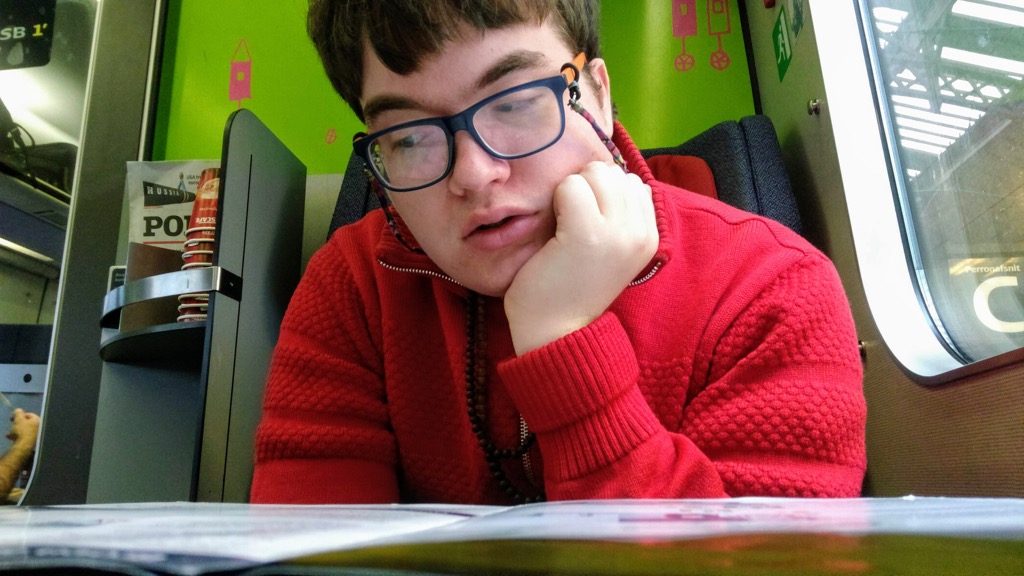
The train pulled into the main Berlin rail station, the Berlin Hauptbahnhof, at 8:30 p.m. We quickly hopped on the S-Bahn to Ostbahnhof, an 8 minute trip. From there we walked to the A&O Hostel on Köpenicker Str. where we arrived just before 9:00 p.m. We checked in, dumped our bags in our room, and walked at a brisk pace to Freiluftkino Kreuzberg, just 500 metres up Adalbertstraße. We bought tickets for The Shape of Water, and took our seats. At 9:15 p.m. Just as the show started. It was the travel equivalent of a perfect game.
Freiluftkino Kreuzberg is one of my favourite places on Earth, period. And it’s certainly my absolutely most favourite place to see films. It’s tucked into a courtyard beside Kunstquartier Bethanien (which also houses Druckwerkstatt, where I spent many happy Tuesdays printing back in 2011). The films are shown outdoors, on a large screen; seating is either in garden chairs or loungers. There is popcorn and German beer. And the scent of pot smoke in the air. And bats and birds flying around. On Monday night it was windy and threatening rain, and thus the perfect night to see a film about a watery monster falling in love.
It was the best way imaginable to start a trip to Berlin.
We woke up on Tuesday morning just a little exhausted from travel (and just a little more from the granite beds at the A&O). After the uninspiring but helpful hostel breakfast we headed over to Companion Coffee to seek an antidote to the hostel coffee (made out of the same materials as the beds, from the taste).
We then hopped on the U-Bahn into Mitte for lunch with my friend Igor, tucking into MUJI for some emergency stationery browsing for a few minutes before our appointment meeting time.
We enjoyed a very pleasant lunch with Igor and his office mate at Made in China on Schönhauser Allee, stopping for (excellent) ice cream at Cuore di Vetro on the way back. We bid our lunchmates goodbye and headed to do your read me?!, the magazine shop of magazine shops, then to R.S.V.P., the stationery store on Mulackstraße that has doubled in size since I was first there in 2011, spreading to a second location across the street. At R.S.V.P. I acquired a lovely Kaweco AL Sport fountain pen that’s just the right size for carrying around all the time, and some cord made from an exotic-sounding material called baumwolle that I later realized is simply cotton (“tree” + “wool”).
With a first round of stationery shopping out of the way, we retired to Hackbarth’s where we met my old friend James, a Canadian long a Berliner, as I’ve written before, a sharer of a childhood barber, and always someone I enjoy catching up with enormously.
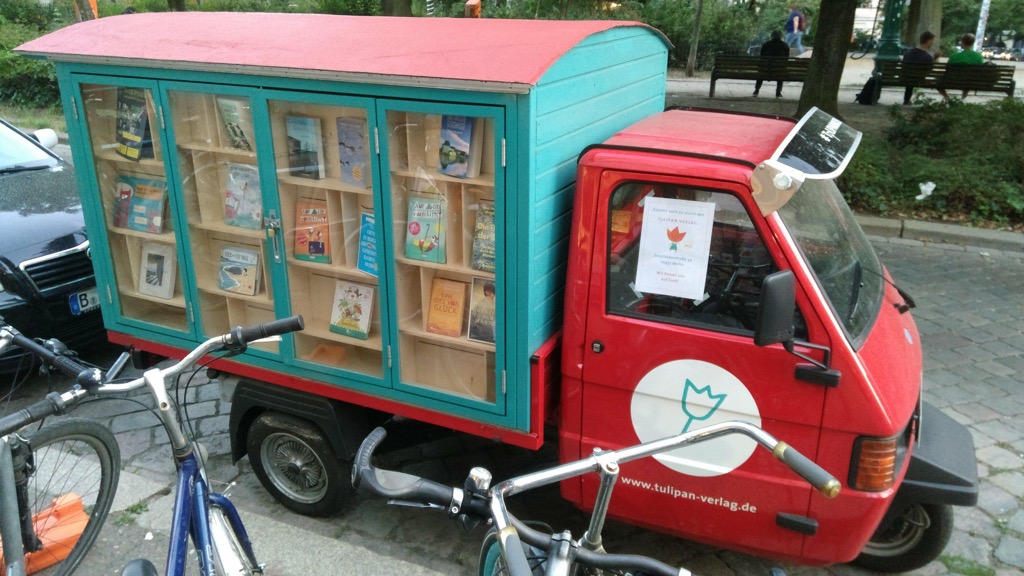
My friend Morgan came along after work to join us for a drink (you’ll remember him from such episodes as The One Where I Blow Up the Car and I Am a Connection Machine) and afterwards we moved on to Salt n Bone for supper, where we were later joined by our friend Tiffany.
We rolled in to the A&O just after 10:30, happy to have spent a day with friends.
On Wednesday morning we subjected ourselves to the A&O breakfast again, but avoided the coffee in favour of an extended morning coffee break with friend Peter, whose office is as well-located an office as I’ve ever seen, embedded as it us in the same complex as Modulor, the world’s greatest stationery superstore. After catching up with Peter we spent almost 2 hours roaming the aisles of Modulor, finding enough unique items of interest to fill a small shipping box; so a trip to the post office around the corner was our next stop (Modulor helpfully has a packing and wrapping station, well-equipped with scissors, tape, kraft paper and string that made this much easier).

For lunch we walked across the street from Modulor to Prinzessinnengarten and shared an meal of creamed chickpeas with cucumbers over rice and couscous while perched on a rattletrap table made out of tree stumps nestled between forest and garden. After lunch we toured the site, and stopped to make some sketches.
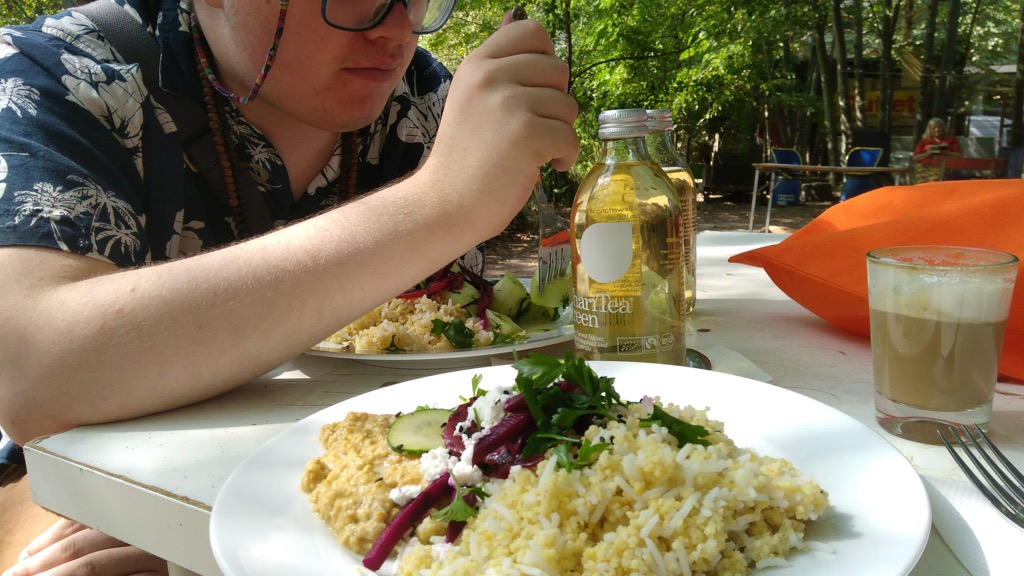

From the Moritzplatz U-Bahn that opens on to both Modulor and Prinzessinnengarten we rode into West Berlin to go to Hamburger Bahnhof, an art gallery in a former train station where we’d never been before, despite many visits to the city. We were lucky to find three intriguing exhibitions in place: a room full of works by Joseph Beuys, Andy Warhol, Robert Rauschenberg and Cy Twombly organized with “thought bubbles” beside each containing a collage of influencing imagery, Hello World, in the upper gallery, “a critical inquiry into the collection of the Nationalgalerie and its predominantly Western focus,” and, on the other end of the building, a monumental collection of installations by Qin Yufen.

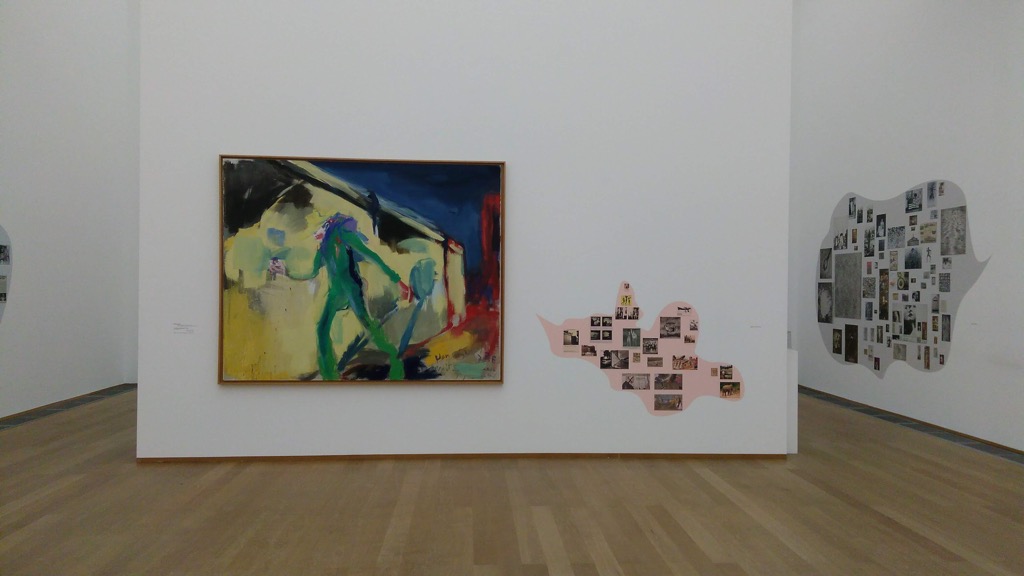
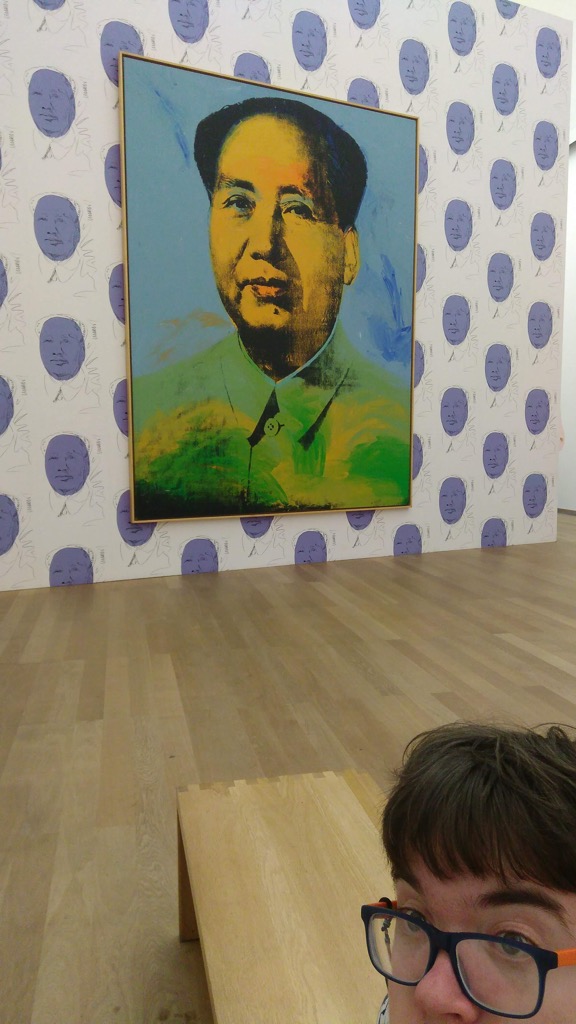
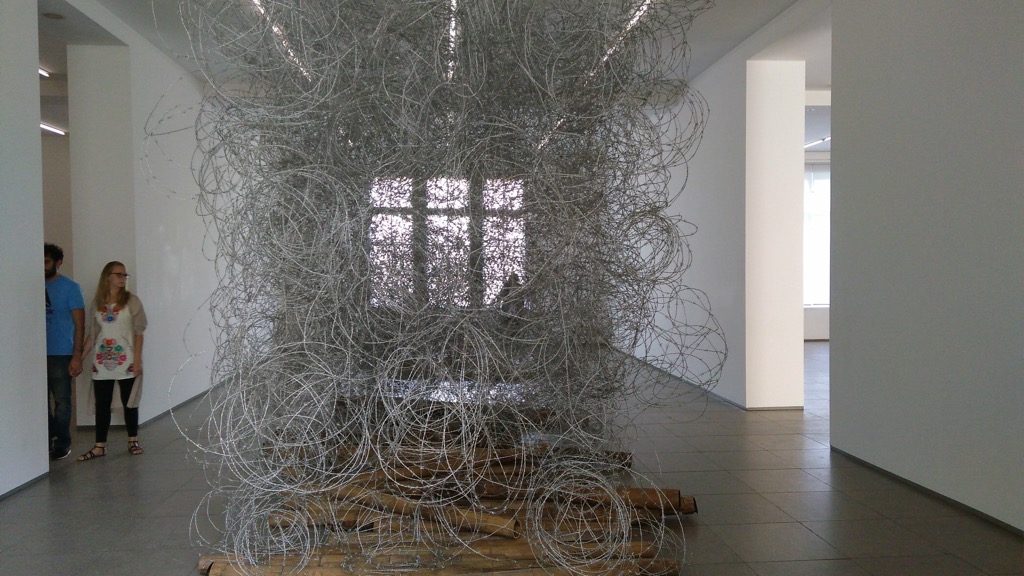
Once we’d toured the gallery we found ourselves tired and thirsty and I debated whether we should simply grab a coffee at the pleasant looking canal-side café attached to the gallery, or forge onward into West Berlin for something possibly more interesting. I channeled Catherine in this regard, and followed what I knew would be her advice to take the easy coffee at hand; this turned out to be exactly the right decision, and we emerged ready for the final activity of the day.
This final activity was a supper, thoughtfully organized by the aforementioned Morgan, at a Shaniu’s House of Noodles on Pariser Str. Morgan is a member of a ragtag group that, over the winter, gets together for a weekly TV watch-and-potluck; he called together a special summer session to visit Shaniu’s, and we were invited to join. The company was a diverse mix of people connected by myriad threads, all interesting; the food was transcendent, with several flavours that were completely new to me.
We arrived at the hostel at an “early” 10:00 p.m. and fell quickly to sleep after a quick round of preemptive packing.
Thursday morning we woke up at the unusually early hour of 7:00 a.m., ready to head east to the Netherlands.

In total we were in Berlin for a little more than 48 hours, and we managed to do a lot of visiting in that short time, and to visit my favourite haunts. Oliver was very, very generous and patient with me, indulging my stationery obsession and abiding many conversations with friends.
As usual, we spent too little time in Malmö, didn’t get to do all the visiting we wanted to do, didn’t get to have all the conversations we wanted to have. But we made a valiant effort to squeeze in as much as we could, and our efforts reached their peak over the weekend.
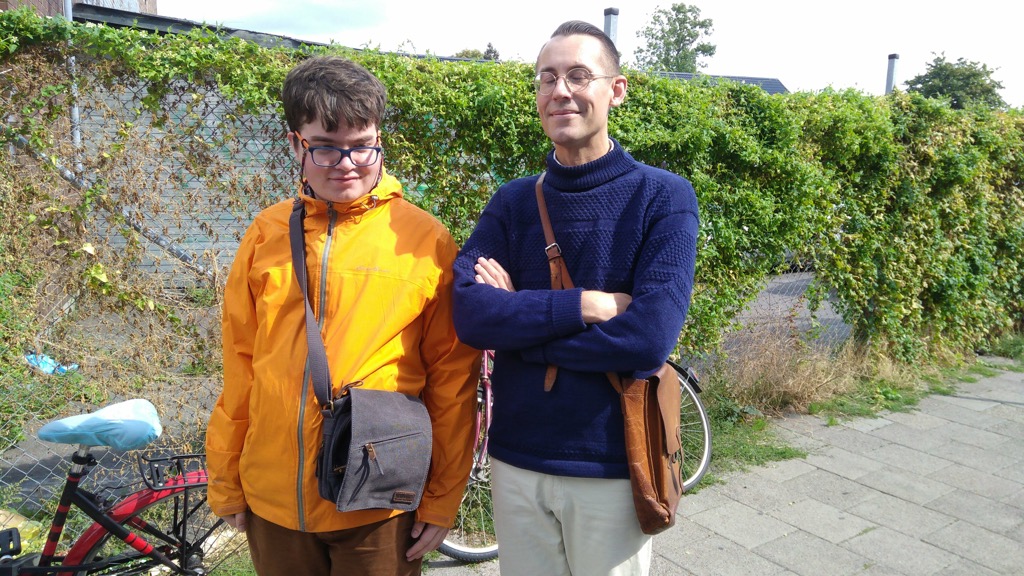
We started off meeting up with [[Olle]] and [[Luisa]] just up the street at ReBike, which was holding a bicycle auction. The auction proved to be dissatisfying, so we redirected to the nearby flea market. We emerged hungry for lunch, and a stop at the McDonalds next door was proposed, an atypical emergency measure given hunger levels (and an opportunity for us to spend our “we’re allow to go to McDonalds once on every European trip if circumstances dictate” allowance). Some of our party being vegans, our visit was predicated on the presence of the McVegan on the menu (yes, this is a thing). It was not on the menu, so we decamped.
At this point Luisa returned home and Olle, Oliver and I redirected to Mitt Möllan, where Olle had Indian food and Oliver and I enjoyed pizza from the excellent Pizza dal Sud.
Sated, we caught a taxi, magically invoked by Olle’s phone, and headed to the Moderna Museet Malmö where we rendezvoused with Olle’s friend David, and took in an exhibition of 19th century photography (upstairs) and a retrospective of the work of Polish artists Katarzyna Kobro and Władysław Strzemiński (downstairs).
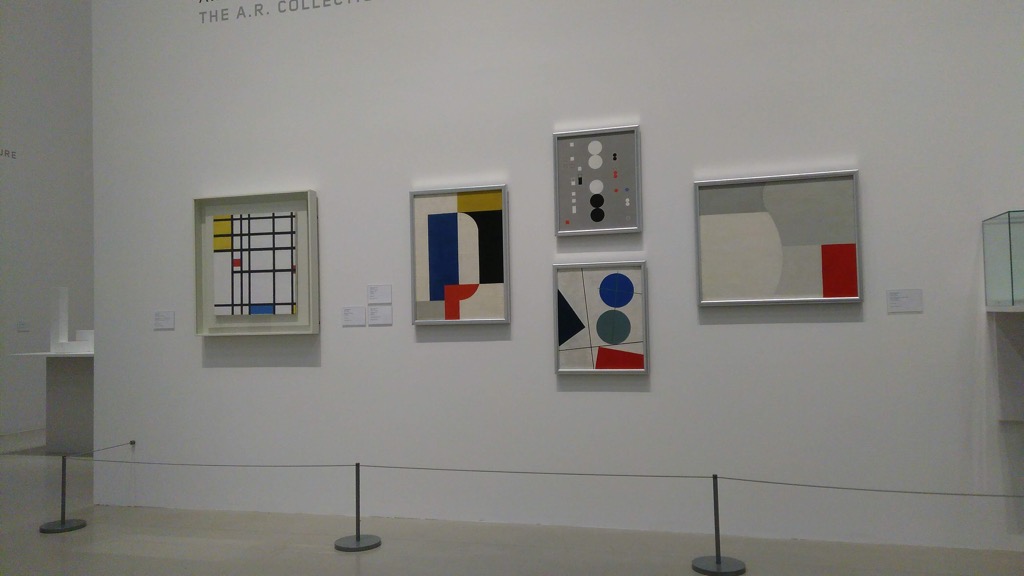
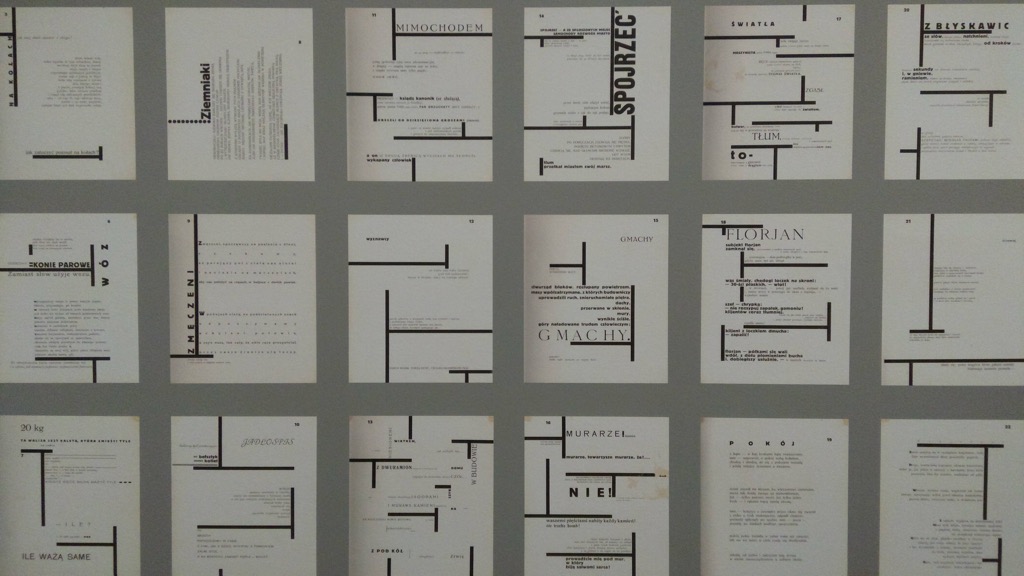
After our visit, we retired to the stratospherically orange café, where we enjoyed coffee and cake and got to know David a little better. He is, we learned, a practitioner of “stealthy” photography–the taking of photos in such a way as the moment is captured without artifice. I decided to try my hand, and, in the flick of a moment, took this photo, which is either a photo of David and Olle, or a photo of the tiny man in the background talking on his mobile.
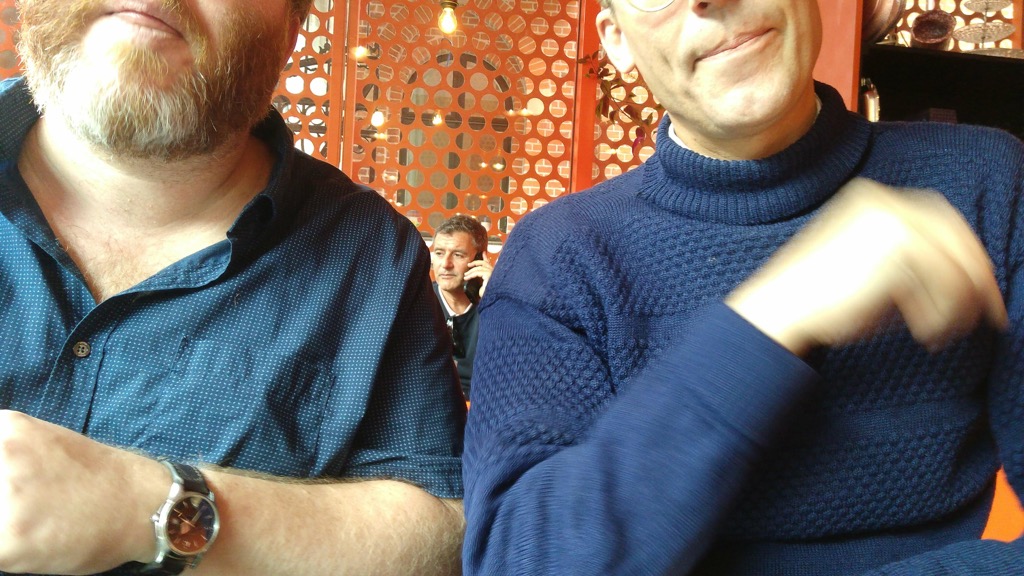
At this point we left David and Olle, and the newly-joining Eric, to their own devices, and headed off in search of an early supper, hopeful that the rain would hold until we were under cover.
We found both food and cover from the rain at Nguyen’s Sandwiches, where we enjoyed tofu bánh mì.
Outside the impending rain became driving rain, and so I quickly pulled out my phone to see if there was a movie we might watch, so as to avoid a soggy walk home. The Children Act, an Emma Thompson film, was starting in 15 minutes just a few blocks away, so we scubaed through the rain and made it just in time. And, in so doing, we got to experience interesting aspects of the Swedish cinema-going experience: reserved seating, a convenience store-like concession (similar to what we saw in Oslo in 2015), and a phalanx of political advertising during the pre-show.
When we emerged 2 hours later, the rain had passed and it was a brisk, bright Saturday evening, perfect for a walk home. While walking I texted Olle to invite him over for tea, and when we arrived he was standing in front of our apartment waiting for us; we did, indeed, drink tea, and ate potato chips, and talked well into the evening.
Sunday morning’s task was to do our laundry.
Our Malmö apartment had a communal laundry room in the basement that we could reserve the exclusive use of for 4 hours using a board in the lobby, affixing a lock to the hour range we wanted. As our key was in the countryside with our apartment’s owner, we were advised to stick a piece of paper in our slot:
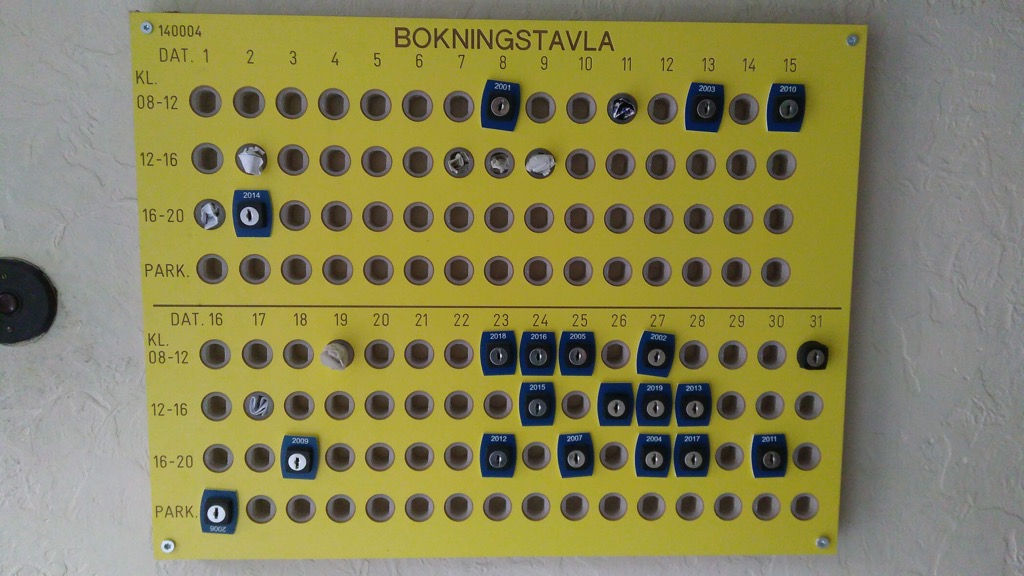
At 8:00 a.m. I packed up our near-week’s worth of laundry and headed down. Only to find the door locked. This was quickly resolved by a ping to our Airbnb host, who had a neighbour unlock the door, and by 8:30 a.m. I was in business, decrypting the not-all-that-hard-to-decrypt Swedish washing machine.
The highlight of the experience, though, was not the washing but the drying, as the drying was done in a C.S. Lewis-sized drying cabinet, with swing-out bars on which to arrange wet clothes. It did an amazing job at drying everything quickly and completely and without wrinkles.
So the laundry was done and folded by 11:00 a.m.
It being Sunday, Oliver expected waffles. Fortunately I had Malmö-based experience in this regard, and we walked down to Kungsgatan Café for its weekend brunch, which included cheeses and meats and buns and granola and yogurt. And make-your-own waffles.
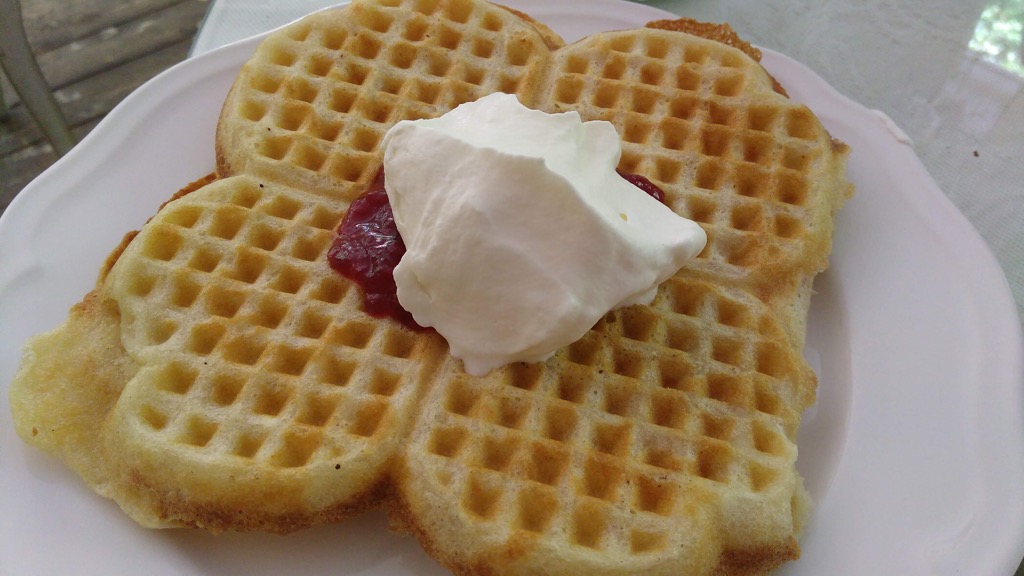
After lunch we took a walk in the sunshine, and then headed to Olle and Luisa’s apartment–just 5 minutes walk away–for a fika they had kindly organized in our honour. In attendance were friends I’d met before–Nene and Loe and Johanna–along with Lovisa and Mikael, who were new. There were cakes, and tarts, and ice cream, and cardamom-infused coffee and delightful company.
The highlight of the fika for me was an extended conversation with Nene about our shared love of fountain pens (her love is deeper than mine, which only served to deepen my own). Nene brought her entire fleet of pens, and kindly allowed me to try them all, and provided helpful commentary about each. She then left me with the unexpected gift of a pen and some intriguing inks. We will, I’m sure, have more to talk about on this in future.
As fika wound down, friend Jonas, who’d had to miss the afternoon to attend a baptism, radioed in and offered to drive us out to his allotment (which, in the Swedish sense, is a community garden plot cum modest summer cottage). We got a cook’s tour of the allotment, followed by a tasty take-out supper of vegetarian bibimbap from Spoonery.
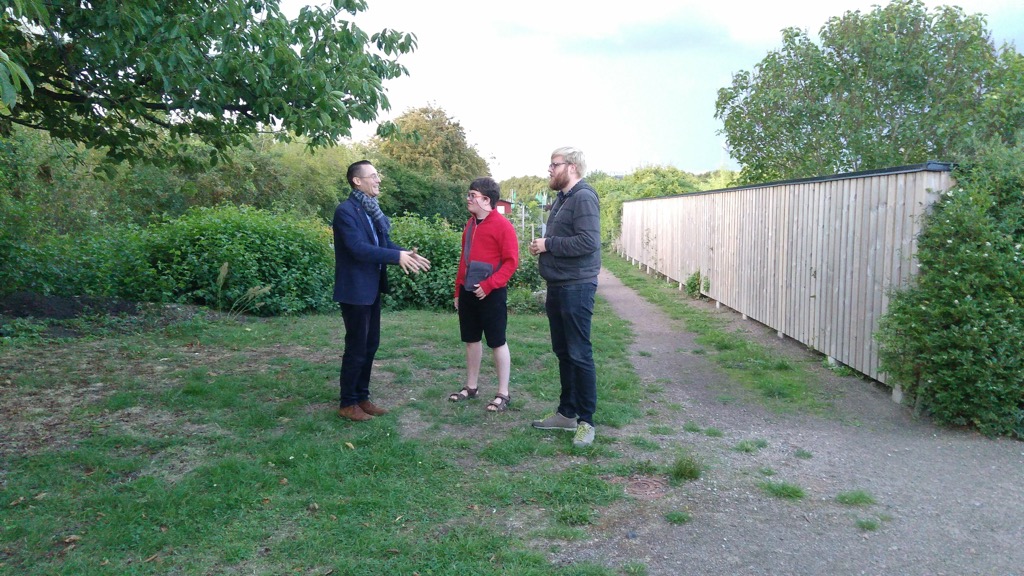
Jonas dropped us back at our apartment late Sunday night, and I finished the day in a frantic drive to clean things up and get organized for our departure for Berlin this morning.
Which is where I type right now, en route presently from Fredericia to Hamburg, with Oliver across the way, wearing a red wool sweater that Olle loaned and then gifted him:

Next stop, Berlin.
It is high election season here in Sweden, and election advertising is on every street corner (and consumed almost all of the pre-show at the movie we went to yesterday).
This ad for the Green Party is especially noticable: “Now,” it reads, “the climate cannot wait.”

We had the pleasure of visiting the Siri Aurdal exhibition at the Malmö Konsthall this afternoon, and while wandering through a forest of tinted plexiglass, I spotted this view of Oliver.
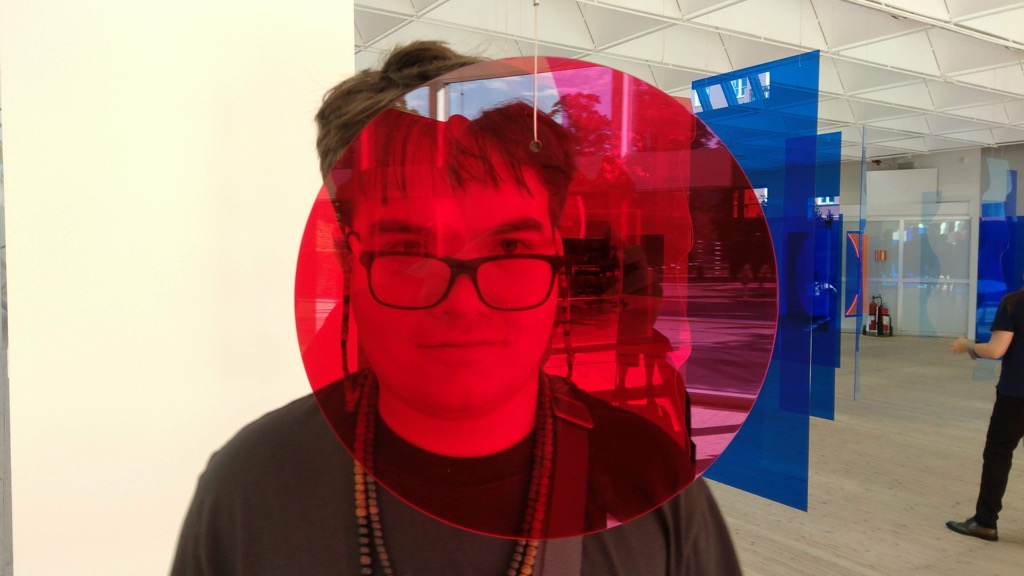
Malmö, like its Danish cousin across the sound Copenhagen, is a bicycling city, and the number and diversity of bicycles inspires awe, especially when compared to Charlottetown, where cycling remains the preserve, primarily, of the young, the car-less and the sporty.
Ever since my first visits to the area a dozen years ago, I’ve looked longingly at the cargo bikes that are used to haul around groceries, IKEA purchases and children. Nine years ago, when Oliver was 8 years old, I test rode a Nihola child-carrying bike with an eye, perhaps, to using it as a family transporter, but nothing came of it. But the candle burns as bright in me now as it did then, and finding myself in Malmö again, this time with Oliver, prompted a return to the notion.
I was fortunate in this regard to have stumbled across Cargo Bike of Sweden online; it’s based just east of the central train station and an easy bus ride from our apartment, and so we headed there this afternoon.
We were placed in the care of the personable Nils, who showed us first the Cargobike Classic Electric, a 6-speed cargo bike with the classic box-in-front design and a 250 watt electric motor for pedal assist. The box was roomy enough that Oliver could fit inside it comfortably, and we could likely squeeze Ethan in as well:

For such an ungainly-looking elephant, it was a joy to ride, and the electric assist allowed us to zip along at a comfortable pace. Oliver reports that the front bucket was comfortable and stable.
After a test drive of the electric assist, Nils asked if we wanted to test ride the non-electric version, and I took him up on it so that I could compare. As you might expect, it felt like pedaling a Sherman tank, and was the best advertisement for the wonders of electric assist you could imagine.
Here’s Oliver in the non-electric model, looking suitably unimpressed (although still comfortable):
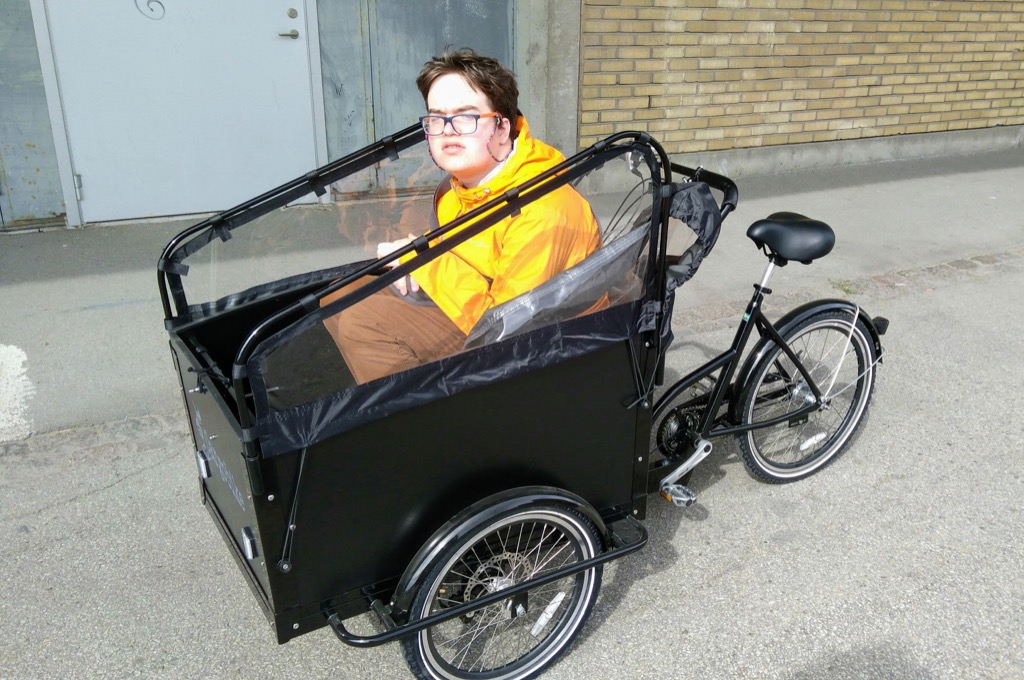
The Cargobike Classic Electric sells for 21,995 SEK ($3142 Canadian); because of a generous rebate from the Swedish state, however, Swedes pay only 16,496 SEK ($2357 Canadian), a savings of 25%. That seems like an eminently reasonable price given what standard e-bikes are selling for. Cost to ship to Canada would need to be factored in, of course (the bike comes in two large boxes, one for the bucket and one for the bike; together they weigh 50 kg).
Our cycling season in Charlottetown is shorter than it is in Malmö where you can almost cycle all year round, but this is still an attractive option, and while we might not get it together for this season, perhaps for next.
On the last episode of “Peter and Oliver Try to Eat at Kao’s” we were dogged by payment challenges, and ended up abandoning the effort and reconciling ourselves to never eating there.
Tonight, however, we met up with our friend Jonas for supper, and, having read yesterday’s post, he suggested we make another attempt at an ascent.
So we walked east 15 minutes–a path well-trod from yesterday–and found ourselves at Kao’s front door, wondering whether they were open or not. It was hard to tell from the outside looking in, whether the lights were on or off, and the hours on the door were suitably confusing that their status was unclear.
“Why don’t you just try the door,” Jonas suggested (why didn’t I think of that?).
So I tried the door.
And as soon as it was open a crack, a piercing siren filled the neighbourhood, the volume and travel of which I’d never heard the likes of before.
Perhaps the person who was closing up remembered to set the alarm, but forgot to lock the front door?
I slowly backed away, and we gingerly and all-innocent-like moved up the block to consider our next move.
Jonas, in a further paean to my vegetarianism, suggested to reroute to Raw Food House, and we heartily agreed.
This required a walk whence we came, but the company was good and the weather pleasant, so we had no complaints.
When we arrived, 10 minutes later, at Raw Food House, we found that it had closed at 6:00 p.m.
Malmö, it seems, does not want me us to eat vegetarian.
We redirected two doors up to Ciao, an Italian restaurant that had the benefit of being open, free of klaxons, and with vegetarian options.
Jonas enjoyed a mushroom pizza, Oliver pasta with beef, and I had a very tasty pear tortellini.
Perhaps we will never eat at Kao’s.
When we returned from a morning out, I investigated Sweden’s replacement of its paper currency a little more, to see what my options were for exchanging my old for some new; I found this helpful answer from Sweden’s central bank:
I am a foreign citizen and I have some Swedish banknotes that has ceased to be legal tender. Where can I exchange them or redeem them?
If you are a tourist and discover that you have invalid Swedish banknotes after you have left the country, you can send them to the Riksbank, who will redeem them. The Riksbank will deposit the appropriate amount of money in your bank account (even if it is a foreign bank account). However, the Riksbank charges a fee of SEK 100 for every redemption case, so there is no point in trying to redeem less than SEK 100.
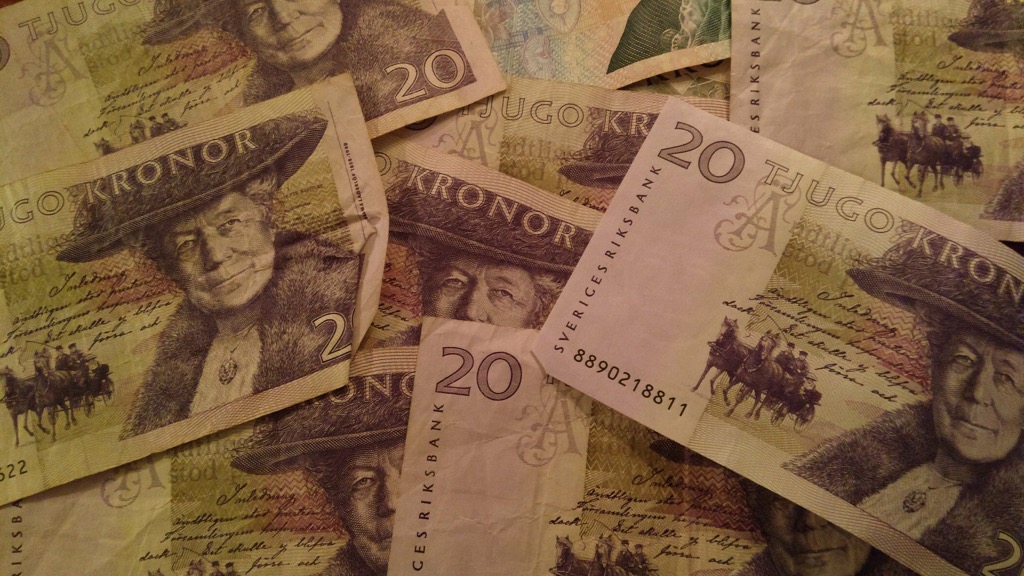
This investigation required that I take my cache of Swedish cash out of my wallet, which required that I take my wallet out of my bag.
Hold that thought.
Oliver, meanwhile, was deep inside Yelp, figuring out where we should eat lunch, and decided we should go to Kao’s, a vegetarian place about 20 minutes walk from our apartment.
We made our way through Möllan toward Kao’s, passing familiar haunts (“hey, Oliver, that’s the bar where Jonas and Olle and I go at 3:00 a.m. when we’ve been out drinking”), and arriving very ready to eat.
To purchase lunch–a buffet–at Kao’s, you pay at the bar next door.
“Shall we pay now,” I asked.
“Either now or later,” replied the barkeep.
I decided to pay in advance, lest I forget.
This was a wise move: I’d left my wallet, absent its currency, on the table in the living room of the apartment, 20 minutes walk away.
“We’ll be right back,” I told the barkeep.
My first thought was that we’d simply walk back to the apartment, retrieve my wallet, walk back to Kao’s, and enjoy lunch.
But it was hot. And we were hungry. And we were on a schedule, due to meet Olle at 4:30 p.m. at the central station.
My next thought was “hey, Oliver has a bank card; let’s find an ATM.”
We wandered around, following the architectural scent of banks, but to no avail.
“I could pay with Google Pay!”, I exclaimed.
But it turned out that when I’d activated my SIM card, I hadn’t set up mobile data. And to get the mobile data settings, I needed mobile data. And I needed mobile data to use Google Pay.
At this point we realized that Skånetrafiken buses have free wifi on them, and it’s possible to connect while the bus is standing in front of you at a bus stop. Hilarity ensued as I tried to connect to bus wifi and Google the settings for my SIM card, all before the bus pulled away. I failed.
I was almost ready to give up, when an open wifi access point appeared on the horizon. I connected, got the Lycamobile APN settings, and got myself fully online.
Back to Kao’s. Kao’s has an old terminal that doesn’t process Google Pay.
“We could take the bus back to the apartment!”, I exclaimed.
I’d even installed the Skånetrafiken mobile app on my phone, ready for just such a situation.
And now that we had mobile data, I could buy a mobile bus ticket.
Back to the apartment on a bus that magically appeared in the right place at the right time.
Found my wallet waiting for me.
Sold Oliver on the idea of not going back to Kao’s, as, by this time, we were really hungry.
Walked to The Masala Box inside the Mitt Möllan arcade and had a delightful vegetarian lunch.
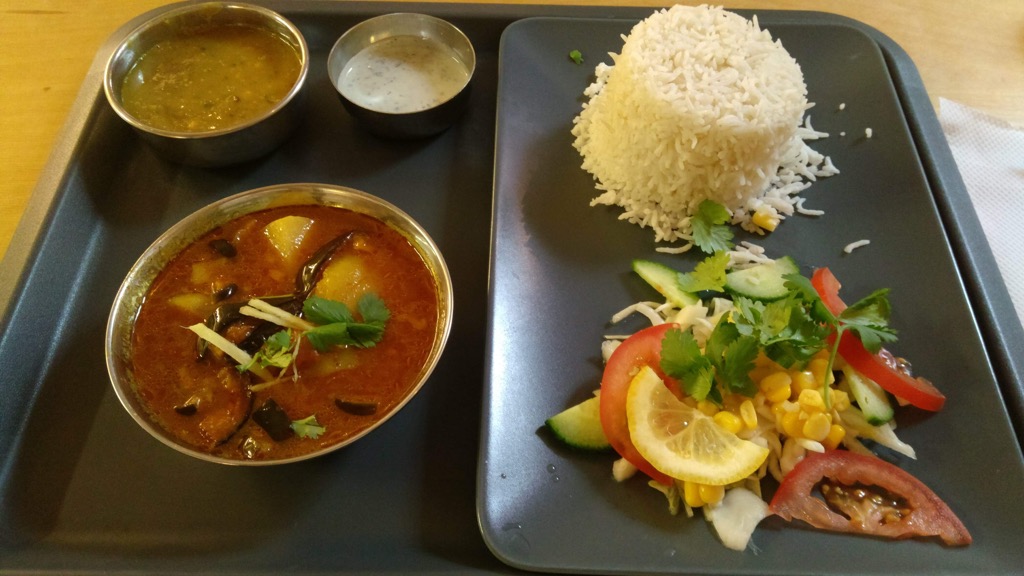
Which I paid for with my credit card.
From there the day only got better: we took the bus to the central station, rendezvoused with Olle, bought sushi for supper, took the bus to Luisa and Olle’s allotment in the near-countryside, and enjoyed a very pleasant evening in their garden, eating sushi and drinking tea.
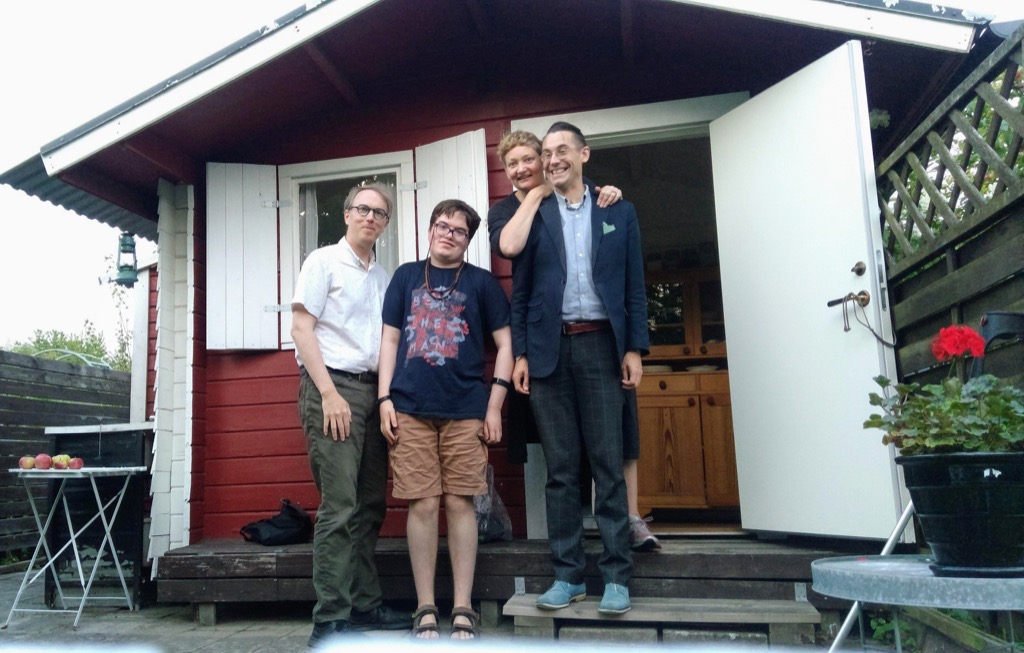
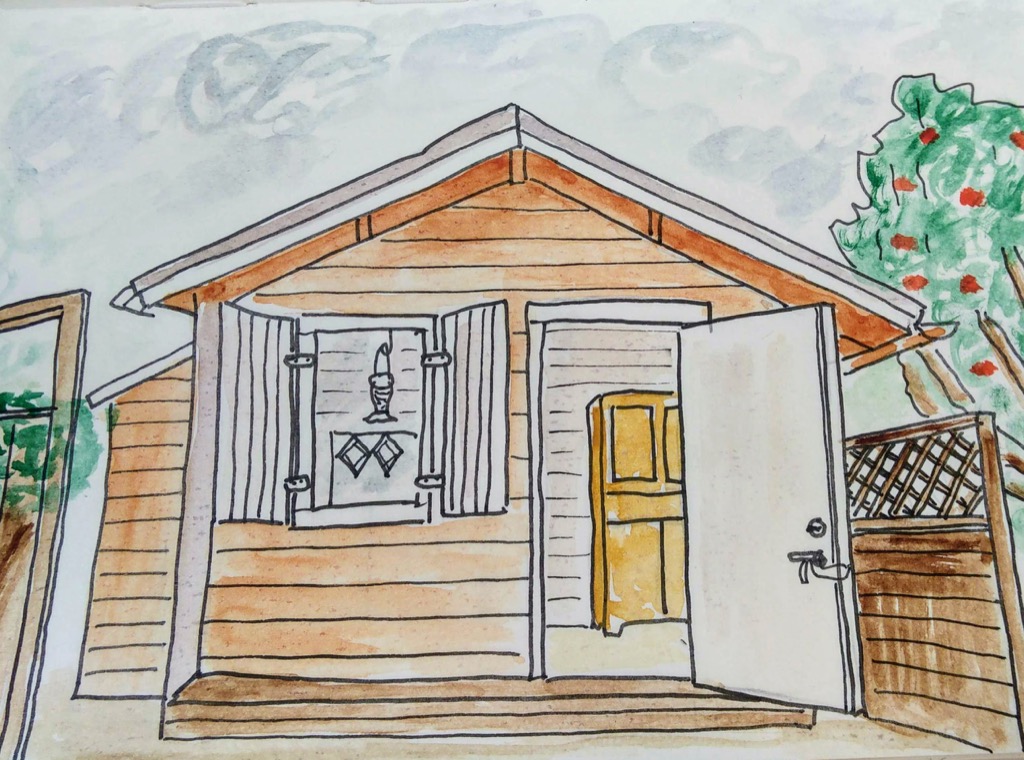
Experience has taught us that it takes the first day in a new place to get set up for paying for things, taking public transit, and making phone calls. We achieved all three, with some adventures to include in our fringe show about father-and-son travel hijinks to boot.
I have a long history of securing SIM cards for travel: if you have friends in Europe and want to interact with them socially, it’s a necessity.
Fortunately, this is something that has only gotten easier over the years, as mobile connectivity has become ubiquitous and mobile network competition vigorous (especially in service of the various diaspora), getting a SIM has gone from something requiring complex gymnastics (sometimes involving passport registration) to something easily picked up at the local newsstand.
There’s also a lot more information about prepaid SIMs for travelers online; the Prepaid Data SIM Card Wiki, for example, has a very helpful page for Sweden.
The other thing that’s happened of late is that roaming fees have been eliminated in Europe, meaning that it’s much easier to get a single SIM for a European trip rather than requiring a new one for each country.
Following the advice of the aforementioned wiki, I resolved to procure a Lycamobile SIM, as it’s advertised as being possible to top-up from outside of Sweden, which has always been a sticking point for me. Lycamobile is a UK firm operating an MVNO in Sweden, and it seems uncommonly diaspora-focused, which is a good thing in terms of multi-language documentation, and accessibility in our neighbourhood here.
After asking around several places and finding that they sold top-up for Lycamobile, but not SIMs, I finally found one at the nearby Pressbyrån in the bus station. I paid 49 SEK (7 CAD) for the SIM, and purchased a 100 SEK (14 CAD) top-up at the same time. I didn’t need to show ID, and I could pay by “tap” with my Canadian credit card (itself a huge improvement over the old days when foreign credit card acceptance in Scandinavia was spotty).
The 100 SEK top-up turned out to be exactly the right amount of top-up, as once I set down to register a plan online, I found that for 99 SEK I could get a 30 day plan with 8GB of data and unlimited calls and texts in Sweden, with 3GB of the data eligible for use while roaming elsewhere in the EU (Canadian readers will, at this point, be wondering why we would pay as much as 8x more than this for the Canadian equivalent).
Registration on the Lycamobile website was easy and in English; I didn’t require a Swedish personnummer (also a sticking point for previous adventures), and I was able to get English support by dialing 3332 from the phone.
Epilogue
I was generally happy with the Lycamobile on my trip through Sweden, Denmark, Germany and the Netherlands, with a few exceptions:
- While I had no problem sending and receiving SMS and calls in Sweden, the LYCA SMART L bundle I purchase didn’t include calls or SMS outside of Sweden. So I had to purchase 50 SEK of “top-up” to be able to use the SIM for anything other than data once I left Sweden, or to call or text outside of Sweden while I was in-country. This was my fault for not noticing the limitation on the description of the bundle.
- Even once I purchased the top-up, I continued to have issues with sending SMS outside of Sweden; I think this was because I didn’t set the “message centre number” (SMSC) in my SMS app on the phone, but I couldn’t for the life of me figure out how to set that in Android 7.1 and Android Messages. I reverted to using Email, Telegram and Signal as a workaround.
- It’s hard to tell from the Lycamobile “My Account” page on its website, but I think that I only used about 500 MB of my 15 GB of data over the 13 days I used the SIM; I was unusually conservative in my data usage, based mostly by my chastening at the hands of Canada’s exorbitant mobile data rates.
- Each time I switch countries (Sweden to Denmark to Germany to the Netherlands), I had to switch the country on the SIM (via the Lycamobile SIM app that gets installed when the SIM is inserted), and then change the APN for data to data.lycamobile.se (it appeared to get erased every time I switch the country), and then, at least some of the time, reboot the phone, to get data to work properly; once I got it working in a country, it worked consistently and without further issue.
- The mobile data was vast and almost ever-present as we were traveling, with a few dead spots on the train in remoter areas.
- As I’d read elsewhere–and one of the big selling features of the Lycamobile SIM–I was able to top-up from outside of Sweden.
- I had occasion to use Lycamobile telephone support a couple of times, and found it courteous and helpful (and English speaking).
After a long day(s) of travel, we arrived in Malmö yesterday around supper, by train from Copenhagen Airport.
By putting our jetlagged heads together we managed to find our Airbnb, a convenient 20 minute walk from the Triangeln station (a station that didn’t even exist the last time Oliver was here, in 2011).
Although we hadn’t made arrangements to meet our Airbnb host, he was conveniently there, just back from a day selling kimchi at a local food festival, and I summoned my last 5% of battery to ask all the pertinent questions (how do we reserve a laundry time? what’s the wifi password? how to we light the stove?).
Once we were on our own and with bearings, we received a kind invitation to pasta with broccoli and garlic from Luisa and Olle, and so walked the short 10 minute walk to their apartment and enjoyed the pleasure of their company well into the evening. As Luisa has said of previous visits, we just picked up the conversation from where we left it off 2 years ago.
Our first sleep in Malmö was fitful, as anticipated; more so for Oliver who, unbeknownst to me, stayed up late trying, in vain, to get his Fitbit on Central European Time (he is a man after his father’s heart; indeed, after his grandfather’s heart even more).
We woke up at a surprisingly normal hour this morning and headed out in search of coffee and breakfast and SIM card; on the way we found the new letterpress studio, Typotopia and, just up the way, a Fotoautomat (with old school analog photo processing).
We found coffee and croissants at Kaffebaren på Möllan, a Lycamobile SIM at Pressbyrån.
We also found that Sweden decided to switch its old paper money out for new, so my Herculean feat of archiving my SEK for re-use on this trip was all for nought.
Oliver’s Fitbit is now on Central European Time and we are following closely behind.
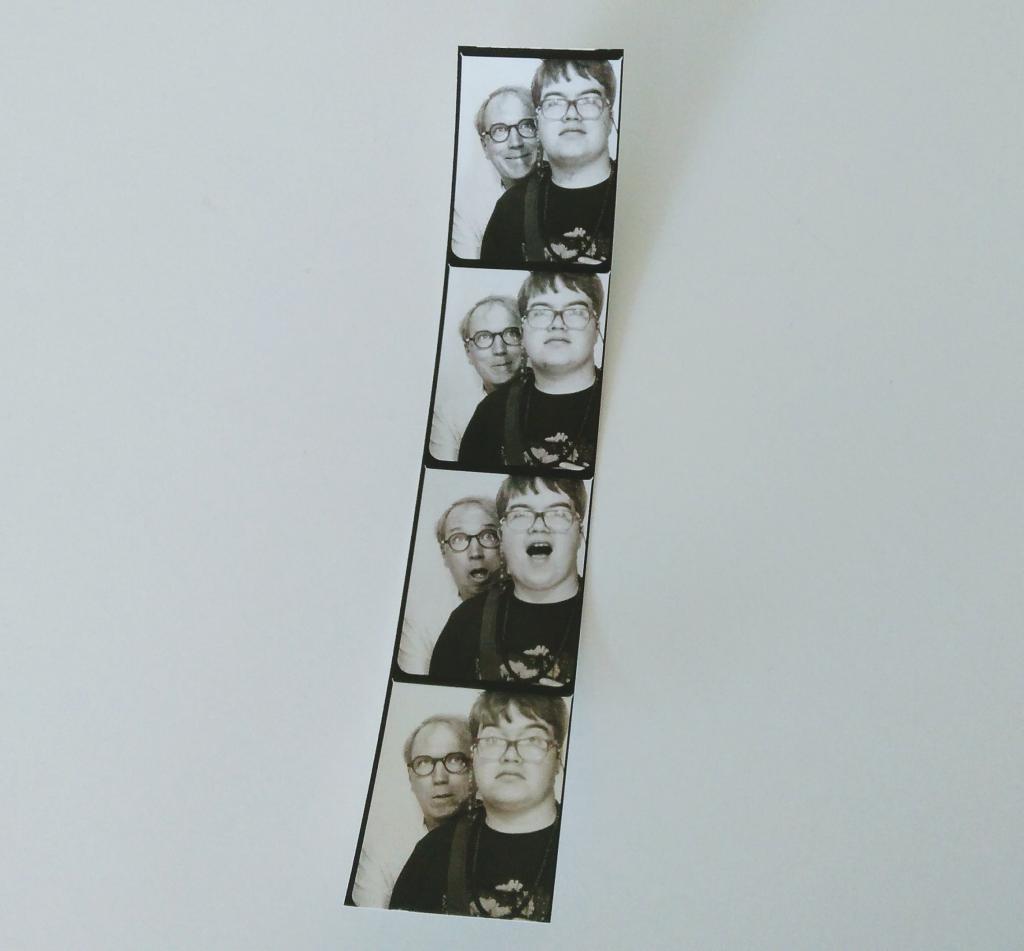
If you’re just joining us, this is a story that started back in 2016 with a rather stressful airport security experience in Toronto–the mother of all bad airport security experiences, you might say. So stressful that it kept me and Oliver out of the air for 18 months.
It’s been a long road back: a big milestone was Autism Aviators, back in May, which was a huge help for Oliver and me, taking us through a realistic airport experience from start to finish in a positive light. It helped reset our stress, and removed some of the triggering power of simply being at the airport.
Next came our June trip by air to Ontario: it started off wonderfully, with an easy, breezy security experience in Charlottetown and a comfortable flight up to Toronto.
The flight back from Toronto didn’t go so well: it wasn’t quite the mother of all bad airport security experiences, but it came close, and while some of this could likely be blamed on a return to the scene of the crime, it demonstrated that the “accessible” line at Pearson Airport is anything but, at least where those with autism are concerned, as the staff were, compared to Charlottetown’s, dreadful morons. Things all came to a head when the agent asked me who takes care of Ethan, and Oliver replied that we both did; this wasn’t an acceptable answer for the agent, and he didn’t handle it well. Things went downhill from there, Oliver got very anxious and lost control, and agents at the next lane started to talk about Oliver. With Ethan’s help, and with complete and total focus on Oliver for about 20 minutes, things calmed down to the point where we could continue. “The daughter of 2016,” said Oliver just now.
I was touch and go on whether we could make this trip to Europe: Oliver really wanted to go; I really wanted to go. But I wasn’t sure I had it in me to help Oliver through another experience like that.
We talked about it, though, and decided to do our best. I boiled the trip down to two security experiences, one in Halifax and one, on the return, at Schiphol in Amsterdam: all our other intra-European travel is by train. But I would be lying if I said I haven’t had some anxiety in the days and weeks leading up to today, as has Oliver.
Oliver’s psychiatrist suggested we consider Lorazepam as a short-acting anxiety-mitigating med; I was anxious about this, in part because Lorazepam, for some people, has the opposite effect, causing anxiety rather than reducing it. So he tried it out on Sunday night. And it had no noticeable effect at all.
We headed to Halifax today with plenty of white space in our schedule, so there was no need to rush. Just before heading to check-in at 7:00 p.m., Oliver took 1 mg of Lorazepam. The line ended up being rather long, and over the next 30 minutes he eased into a mellow that rendered him slightly more relaxed and a lot more sleepy. He wasn’t catatonic, though, and was happy and conversational and even a bump at check-in (I reserved us seats, but for the return flight, not for tonight) didn’t phase him.
When it came time to go through security, we asked to go through the “family line,” and the friendly CATSA triage agent happily ushered us to a line with no wait where we were greeted by another friendly CATSA agent who ushered us into an empty checkpoint where we were greeted by a third friendly CATSA agent who gently walked us through our carry-on disgorging.
Oliver then simply walked through the security gate.
And then I walked through the security gate, and it was set off; a “random selection” said the agent. Oliver remained unphased, and took a seat to wait. A jig and a jag with the sensor wand and I was released. We gathered up our luggage and headed to the departure gate. Calm as can be.
Why was this time so smooth when Toronto was a debacle?
Certainly the Lorazepam helped, but I’d credit it with a nudge toward mellow, not with saving the day. The attitude and helpfulness and palpable lack of anxiety demonstrated by the CATSA staff was a huge help. Autism Aviators was a huge help. Oliver working really, really hard to keep calm was a huge help. It was a good idea to leave lots of time and to arrive plenty early. It was a good idea to spend our pre-check-in waiting time outside of the melee of the airport proper. It was a good idea to visit security before check-in, just to get the lay of the land.
Whatever combination of work, pharma, planning and luck were at play today, I’ll take it: it wasn’t until we had cleared security that I realized how worried I had been about Oliver and this trip. For months. It’s nice to have that weight off my shoulders, especially as we start our summer vacation.
(As I do with all blogs posts that concern the intimate ins-and-outs of living with autism, I asked Oliver to read this with an eye to accuracy and privacy, and he gave his okay for me to post, with hopes that others will find his experiences a helpful guide for their own travels).

 I am
I am